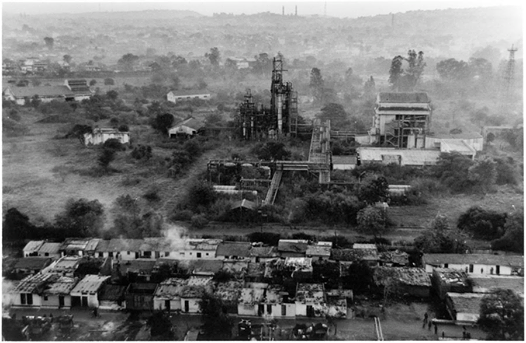
In a significant development for the Bhopal Disaster case, the United Nations Environment Programme (UNEP) has offered to undertake a full evaluation of the spread of toxic waste at the derelict Union Carbide factory in Bhopal.
A full contamination assessment has never been made and toxic waste abandoned in and around the factory site continues to poison local residents over thirty years since the 1984 Bhopal Gas Tragedy most significantly by leeching into the groundwater aquifer that supplies their drinking water.
This contamination disaster is a major public health issue affecting tens of thousands of poor people in the slum areas surrounding the abandoned Union Carbide pesticide factory. It is the second chemical disaster to befall Bhopal and is a separate matter from the 1984 Bhopal Gas Tragedy. There has been no settlement of any kind, no compensation has been paid, and there has been no attempt at meaningful environmental clean up.
UNEP has approached the Indian Government via the Ministry of Environment and Forest (MoEF). The Indian Government must formally invite UNEP to Bhopal and the Minister has asked for 15 days toconsider the offer.
“It would be a comprehensive assessment of the 3.5 km area, that continues to affect inhabitants in some 22 colonies,” said Rachna Dhingra, representative for Bhopal Group for Information and Action (BGIA). She said that several studies have been undertaken since 1990 but none have been comprehensive.
Greenpeace issued a report, as early as 2002, ‘Technical guidelines for cleanup at the Union Carbide India Ltd (UCIL) site in Bhopal’ proposing assessment and treatment protocols:
“The entire factory site and the surrounding areas, including the ‘solar evaporation pond’ areas where wastes have been landfilled, should be systematically sampled, using a grid pattern reinforced with extra samples at visibly contaminated locations. Samples should be collected from the surface and at regular depths to establish the extent of subsoil contamination… if those furthest from the site show any signs of contamination, the testing area should be extended until no further contamination isdetectable.
By 2009, a round of tests performed by Delhi-based ‘Centre for Science and Environment (CSE) showed the greatest pesticide contamination (in ground water samples) at Shiv Nagar a distance of 3.5km to the North East of the UCIL site. Further tests, any greater distance away from the factory site, are yet to be performed.
Colin Toogood, Bhopal Medical Appeal spokesman said:
“There are 22 communities, comprising around 50,000 people, now officially acknowledged as affected by the contaminated groundwater; but the unfortunate truth is that nobody knows how far the contamination has spread into the aquifer and, thus, how many communities are actually affected. They cannot possibly know this until a full contamination survey is finally performed- nor can they know how many people are still being poisoned in Bhopal’s Second Disaster”.
“The contamination situation in Bhopal is an environmental crisis and a medical emergency. We welcome UNEPs offer and insist that the Ministry of Environment and Forest issue a formal invitation.”
Notes:
This contamination disaster is a separate matter to the 1984 Gas Disaster. It has been caused by toxic waste dumped whilst the Union carbide factory was in production leeching toxic chemicals into the local groundwater.
There is no connection to the $470m payout made by Union Carbide in respect of the civil case pertaining to the Gas Tragedy.
The US courts accept that this ongoing contamination issue is distinct from the 1984 Gas Disaster and the ‘polluter pays principle’ sees Dow, as the successor company to UCC, liable for the contamination.
- The groundwater aquifer in Bhopal, around the abandoned Union Carbide factory (site of 1984 Bhopal Gas Disaster), is heavily contaminated with highly toxic chemicals.
- This contaminated groundwater has been the primary drinking water source for tens of thousands of people for many years and, in some cases, since before the Gas Disaster. Although a local government scheme has seen water piped in to many of the previously affected communities these supplies can be intermittent and unreliable leaving the communities with no option other than to use the contaminated water.
- A full contamination survey has never been performed and, in areas where there is no piped, or other supply, an unknown number of families still use the contaminated water as their primary water source.
- The chemicals leaching in to the water are highly toxic. They attack all of the body’s organs, some are known carcinogens, and others cause birth defects.
- The contamination is being caused by water leaching through toxic waste that was buried on the factory site and by leakage from solar evaporation ponds located just outside of the factory site.
- The solar evaporation ponds are known to have been leaking years before the disaster (an internal Union Carbide memo from 1982 reveals this).
- Union Carbide was aware of the environmental and groundwater contamination, after carrying out tests in the area, but chose to keep the findings of these tests secret.
- The toxic contamination of the area only became public knowledge when Greenpeace tested the area and published a report, in 1999, labeling the area a ‘global toxic hotspot’.
- The US courts accept that the water contamination is a separate issue from the gas disaster.
- Dow Chemical, as current owner of Union Carbide, is responsible for the continuing contamination.


